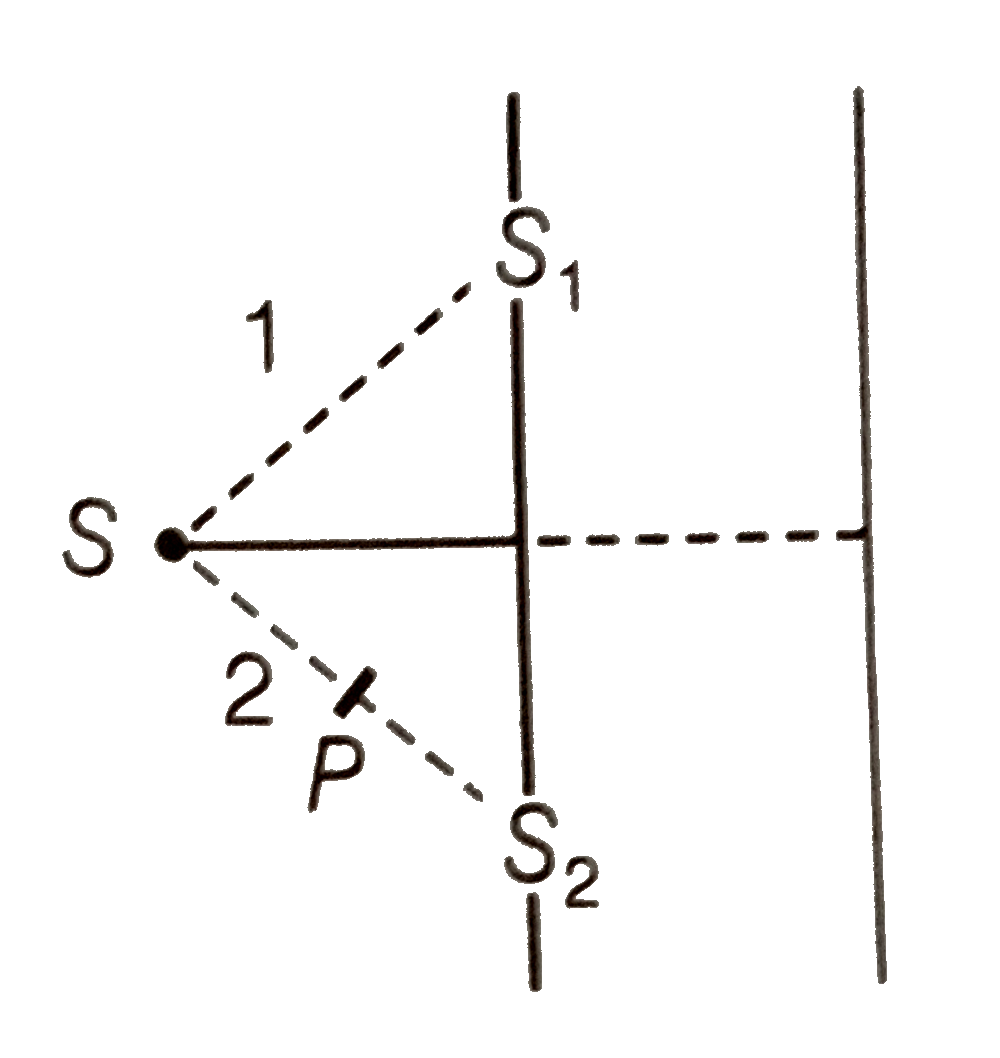Figure shown a two slit arrangement with a source which emits unpolarised light. P is a polariser with axis whose direction is not given. If is the intensity of the principal maxima when no polariser is present, calculte in the present case, the intensity of the principal maxima as well as the first minima.

The correct Answer is:A
Without P:
where are the amplitudes fo either of the beam in and polarizations.
intensity
With P:
Assume is blocked:
Intensity
Intensity without polariser at principal maxima).
Intensity at first maxima with polariser
Intensity at first minima with polariser,
Topper's Solved these Questions
- WAVE OPTICSBook:NCERT FINGERTIPSChapter:WAVE OPTICSExercise:NCERT Exemplar
Explore 5 Videos
- WAVE OPTICSBook:NCERT FINGERTIPSChapter:WAVE OPTICSExercise:Assertion And Reason
Explore 15 Videos
- WAVE OPTICSBook:NCERT FINGERTIPSChapter:WAVE OPTICSExercise:Polarisation
Explore 18 Videos
- SEMICONDUCTOR ELECTRONICS : MATERIALS , DEVICES AND SIMPLE CIRCUITS Book:NCERT FINGERTIPSChapter:SEMICONDUCTOR ELECTRONICS : MATERIALS , DEVICES AND SIMPLE CIRCUITS Exercise:Assertion And Reason
Explore 15 Videos
Similar Questions
Figure shown a two slit arrangement with a source which emits unpolarised light. P is a polariser with axis whose direction is not given. If I0 is the intensity of the principal maxima when no polariser is present, calculte in the present case, the intensity of the principal maxima as well as the first minima.

View SolutionWhat is meant by a linearly polarised light? Which type of waves can be polarised? Briefly explain a method for producing polarised light. Two polaroids are placed at 90∘ to each other and the intensity of transmitted light is zero. What will be the intensity of transmitted light when one more polariod is placed between these two bisecting the angle between them ? Take intensity of unpolarised light as l0
View Solution
Knowledge Check
As shown in figure a two slit arrangement with a source (S) which emits unpolarised light. I0 is the intensity of principle maxima when no polariseer is present. Now a polarised 'P' is placed as shown with its axis whose direstion is not given. Then
 Athe intensity principal maxima is 58I0Bthe intensity of principal maxima is I02Cthe intensity of first minima is zeroDthe intensity of first minima is I08
Athe intensity principal maxima is 58I0Bthe intensity of principal maxima is I02Cthe intensity of first minima is zeroDthe intensity of first minima is I08An unpolarised light of intensity I0 falls on a polarised whose optic axis is inclined at 45∘ to the incident light. Then the intensity of light emerging from the polarised is :
AI0BI02CI04DZeroWhen an unpolarised light of intensity I0 is incident on a polarising sheet, the intensity of the light which does not get transmitted is
AzeroBI0C12I0D14I0
Two 'crossed' polaroids A and B are placed in the path of a light-beam. In between these, a third polaroid is C is placed whose polarisation axis makes an angel θ with a polarisation axis of the polaroid A. If the intensity of light emerging from the poloaroid a is Io then show that the intensity of light emerging from polaroid B will be 14Iosin2θ.
View SolutionA monochromatic beam of light of 6000 Å is used in YDSE set-up. The two slits are covered with two thin films of equal thickness t but of different refractive indices as shown in figure. Considering the intensity of the incident beam on the slits to be I0, find the point on the screen at which intensity is I0 and is just above the central maxima. (Assume that there is no change in intensity of the light after passing through the films.) Consider t=6μm,d=1mm, and D=1m, where d and D have their usual meaning. Give your answer in mm.

View SolutionA beam of unpolarised light of intensity I0 is passed through a polaroidA and then through another polaroid B which is oriented so that its principal plane makes an angle of 45∘ relative to that of A. The intensity of the emergent light is
View SolutionLight from two coherent sources of the same amplitude A and wavelength λ illuminates the screen. The intensity of the central maximum is I0. If the sources were incoherent, the intensity at the same point will be
View SolutionA polariser is place in a pth of unpolarised light of intensity I0 An another polariser is placed in such a way that its axis makes an angle 30∘ with first. Opne The intensity of emergent light will be
View Solution

